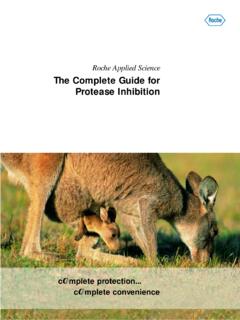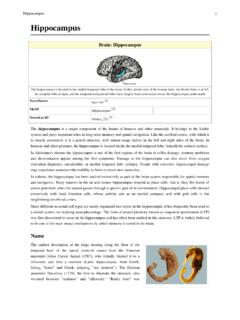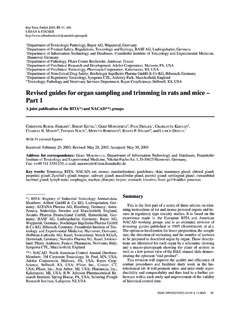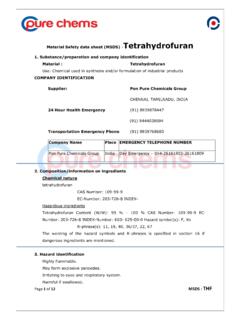Transcription of United States Office of Prevention, Pesticides Pesticide ...
1 United States Office of prevention , Pesticides Environmental Protection and Toxic Substances Agency (7501C). Pesticide Fact Sheet Name of Chemical: Boscalid Reason for Issuance: New Chemical Date Issued: July 2003. Description of Chemical Chemical Name: 3-pyridinecarboxamide, 2-chloro-N-(4'chloro[1,1'biphenyl]-2-yl) . Common Name: Boscalid (BAS 510). Trade Names: Emerald, Endura, and Pristine Chemical Class: Carboxamide aka anilide EPA Chemical Code: 128008. Chemical Abstracts Service (CAS) Number: 188425-85-6. Year of Initial Registration: 2003. Pesticide Type: Fungicide Producer: BASF. Use Pattern and Formulations Boscalid is a fungicide consisting of two formulated end-use products for use on food crops.
2 The wettable granule (WG) Endura Fungicide contains 70% active ingredient, and the wettable granule (WG) Pristine contains a mixture of boscalid ( active) and pyraclostrobin ( active). Endura is intended for use on beans, berries, bulb vegetables, canola, carrots, fruiting vegetables, grapes, lettuce, peanuts, pistachios, potatoes, stone fruit, strawberries, tree nuts, Brassica vegetables (subgroups 5A and 5B), cucurbit vegetables, mint, edible peas, certain root vegetables, and sunflower. Pristine is intended for use on berries, bulb vegetables, carrots, grapes, pistachios, stone fruit, strawberries, and tree nuts. Application is via multiple, foliar, broadcast sprays at a seasonal rate of ca lbs ai/A, depending on crop and target disease.
3 Typically, retreatment intervals are 1-3 weeks and minimum PHIs are 0-30 days. 1. There is also a formulated 70% wettable granule end-use product named Boscalid Turf Fungicide for use on golf course turfgrass. No other residential uses have been proposed. Science Findings Summary Science Statement The Agency has completed its review of the product chemistry, toxicology, residue chemistry, occupational exposure, ecological effects and environmental fate data submitted in support of the registration of boscalid. The toxicology data base for boscalid is adequate to support the requested field use registrations and tolerances. There is high confidence in the hazard endpoints and dose-response assessments conducted for this chemical.
4 Boscalid is classified as suggestive evidence of carcinogenicity, but not sufficient to assess human carcinogenic potential . Therefore, a cancer risk assessment is not required. The Agency has considered available information on boscalid's toxicity, potential use areas, fate properties, and application methods in characterizing ecological risks related to labeled use. Boscalid is persistent, it has low mobility in soil; however, boscalid may move to surface water through spraydrift and runoff of soil and suspended sediments. The degree of surface water contamination is mitigated by the relatively low seasonal application rates ( lbs ai/acre/season) and its tendency to sorb to soil and sediment.
5 The compound does not bioaccumulate appreciably in fish (BCF 35X- 105X). The fungicide is practically nontoxic to terrestrial animals and is moderately toxic to aquatic animals on an acute exposure basis. Boscalid acute risk quotients (RQs) do not exceed acute risk levels of concern and is not likely to pose an acute risk to animals at the maximum use rate. The RQ is not an absolute estimate of the likelihood, magnitude, or severity of risk. Inputs into this screening level assessment were designated to overestimate likely exposures and effects of boscalid. Given the slight exceedences of the RQs and the label limitations that will be imposed for boscalid, the Agency believes that potential ecological risks are low.
6 Physical/Chemical Properties Physical and Chemical Properties for Technical Grade Active Ingredient Result Requirement White powder (TGAI); White crystalline (PAI). Color/Physical State TGAI - faint smoky Odor PAI - odorless The test substance was found to be stable at RT and 54C for 14 days. The test Stability substance was also found to be stable when exposed to metals like AI, & Fe, and to corresponding acetate ions. It reacts very weakly with potassium permanganate but does not react with iron, Oxidation/Reduction water or the fire extinguishing agent monoammonium phosphate (MAP). It is a very 2. weak reducing agent..Not applicable Flammability Non-explosive Explodability Not required for a TGAI.
7 Accelerated storage at 54 o C, in glass: day 0 - Storage Stability , day 30 - .Not applicable Miscibility The test substance is not expected to be corrosive to the commercial Corrosion Characteristics storage container at 23 C (1% solution). pH..Not applicable Viscosity C (TGAI); (PAI). Melting Point/. Melting Range Density g/cm3 (TGAI); g/cm3 (PAI). Test substance does not dissociate Dissociation Constant in Water log P o/w = ; P o/w = 915 @ 21 C. Partition Coefficient (Octanol/Water). PAI at 20 C in acetone (16-20 g/100 ml); acetonitrile (4-5 g/100ml);. Solubility: methanol (4-5 g/100 ml); ethylacetate ( g/100 ml); dichloromethane (20- 25 g/100 ml); toluene ( g/100 ml); 1-octanol (<1 g/100 ml; water, 6.)
8 Mg/L@20 C). Vapor Pressure 7 x 10-9 hPa (PAI at 20 C); 2 x 10-8 hPa (PAI at 25 C). Toxicological Characteristics: Acute Toxicity Profile - Boscalid Technical Test Tox Material GDLN Study Type MRID Results Category Technical Acute Oral - 45404814 LD50 > 5000 mg/kg IV. rat Technical Acute Dermal - 45404815 LD50 > 2000 mg/kg III. rat Technical Acute 45404816 LC50 (M & F): > IV. Inhalation mg/L. Technical primary Eye 45404817 Not irritating to the eye IV. Irritation 3. Technical primary 45404818 Not irritating to the skin IV. Dermal Irritation 4. Technical Dermal 45404819 Study unacceptable as N/A. Sensitization challenge dose was inadequate Toxicity Profile of Boscalid Technical.
9 Guideline No. Study Type Results 90-Day oral toxicity NOAEL: 34/159 mg/kg/day (M/F). rodents (rats) LOAEL: 137/395 mg/kg/day (M/F): M = increases in absolute and relative thyroid weights and increased incidence of thyroid hyperplasia as well as follicular epithelial hypertrophy; F = increases in absolute and relative thyroid weights. 90-Day oral toxicity NOAEL: 197/2209 mg/kg/day (M/F). rodents (mice) LOAEL: 788/2209 mg/kg/day (M/F): M = increased liver weights and increased incidence of marked fatty change in the liver; F = not attained 90-Day oral toxicity in NOAEL: mg/kg/day (M/F). nonrodents (dogs) LOAEL: mg/kg/day (M/F): M = increased alkaline phosphatase activity and hepatic weights; F.
10 = increased alkaline phosphatase activity and hepatic weights. 21/28-Day dermal toxicity NOAEL: 1000 mg/kg/day (HDT). (rats) LOAEL: >1000 mg/kg/day Prenatal developmental in Maternal NOAEL: 1000 mg/kg/day rodents (rats) Maternal LOAEL: cannot be established Developmental NOAEL: 1000 mg/kg/day Developmental LOAEL: cannot be established Prenatal developmental in Maternal NOAEL: 300 mg/kg/day nonrodents (rabbit) Maternal LOAEL: 1000 mg/kg/day based on abortions or early delivery. Developmental NOAEL: 300 mg/kg/day Developmental LOAEL: 1000 mg/kg/day based on abortions or early delivery. Reproduction and fertility Parental systemic effects (rat) mg/kg/day (M/F). Parental systemic > 5.

















